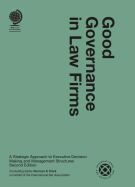How well does your conflicts system work?
12 December 2014

Author bio coming soon
Contributor to Risk Management in Law Firms, Frank Maher, explores the common pitfalls responsible when conflicts issues go wrong.
In the course of acting as a solicitor for law firms for over 30 years – both defending professional indemnity claims and advising on professional regulation – the author has encountered many issues arising from conflicts of interest; much pain has been endured by those who fell foul of the rules.
When conflicts issues go wrong, they can be among the most damaging to a firm’s reputation – and reputation is the only thing we have to sell.
Problems in practice fall into several categories, including:
- the conflict checking system failing to pick up the existence of a conflict, or significant risk of one, at all;
- acting for two or more clients, such as joint venture partners or husband and wife, and failing to spot either that their interests conflict at the outset or that they may do so further down the line;
- failing to spot when a conflict does arise in the future, as may happen when acting for lender and borrower, in some cases because the problem has unfolded gradually;
- taking on a small matter which precludes the firm from acting on something more substantial later;
- allowing a large client to impose its terms of business (or ‘outside counsel guidelines’) which impose more extensive duties than would apply at law and under the conduct rules;
- establishing systems which check for client conflicts, but fail to check at all for own interest conflicts, such as personal appointments as trustee or director;
- failing to spot that the solicitor’s own interests may conflict – perhaps the volume of work from one client, such as an insurer, and the desire not to offend it or appear uncommercial blinds the solicitor to the risk of conflict with the insured; and
- relying on information barriers when they are either not appropriate at all (because at most they may protect confidential information, but will not cure a conflict), or inadequate for the purpose they seek to achieve.
This list is not exhaustive. Each of these merits a substantial article on its own; but unless the firm sorts out the first one – the integrity of the conflict checking system – there is little prospect of addressing the more complex ones.
The largest firms centralise their client and matter inception systems, including not only conflicts, but also anti-money laundering, sanctions, creditworthiness and risk appetite. This has much to commend it for all but the smallest firms, as it can provide a better-quality process, avoiding some of the gaps identified below; and those administering it become more expert. But the decision on whether to act must, of course, be that of the lawyers – the administrative staff can only provide the information on which to base a decision.
Many firms rely on circulating emails with details of new instructions, but this relies on people reading them and we have encountered partners who admit to ignoring them routinely. In any event, people will be out of the office from time to time on holiday or in the normal course of practice, and are unlikely to pay the same attention to the emails while they are away. It may help, but it is not a system.
Does your system only check for clients? Do you include subject matter, such as property or patents? Does your system check the clients’ addresses too? Some do not. What happens in the case of a confidential matter designated by a project name? And once it is in the public domain, do you update the system? Do your systems reflect changes in the status of matters as they progress, such as the addition of new parties to litigation or a new lender? Do fee earners understand the need to repeat searches when circumstances change? Are prospective clients included, to avoid the risk outlined earlier of taking on a small matter which precludes the firm from acting on something more substantial?
What happens with related parties – partners in a firm, directors, shareholders and the like?
And how do you address the risk of spelling variations (eg, Stephenson or Stevenson), simple typographical errors and foreign alphabets?
These are just some of the questions which need to be considered, but they point to the need for a wider review of processes and firm-wide training. When a firm encounters a conflict, the stakes can be high, with substantial damage to reputation, loss of clients, liability claims, litigation, written-off fees and disciplinary action.
Fee earners may see conflict systems as something in the way of opening a file or a rule to be worked around, but securing buy-in is possible once they understand that making the system work may help them avoid turning away valuable work, writing off bills and chargeable time, losing clients and doing something today which they regret tomorrow.
Those who decide to ignore the risks may rue the day.
Frank Maher is a partner in Legal Risk LLP, a solicitors firm specialising in professional regulation and professional indemnity, and advises leading UK, US and other international firms on conflict issues.
He was the lead author of chapters on conflicts and confidentiality in the newly published book published by Globe Law and Business in association with the International Bar Association, Risk Management in Law Firms.













Any comments - send us an email